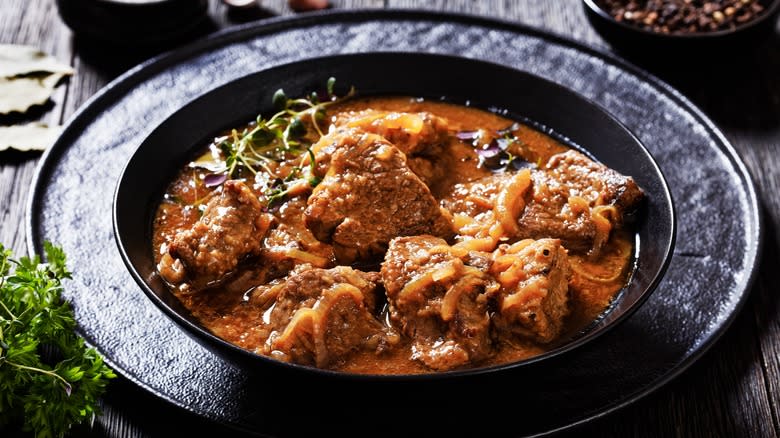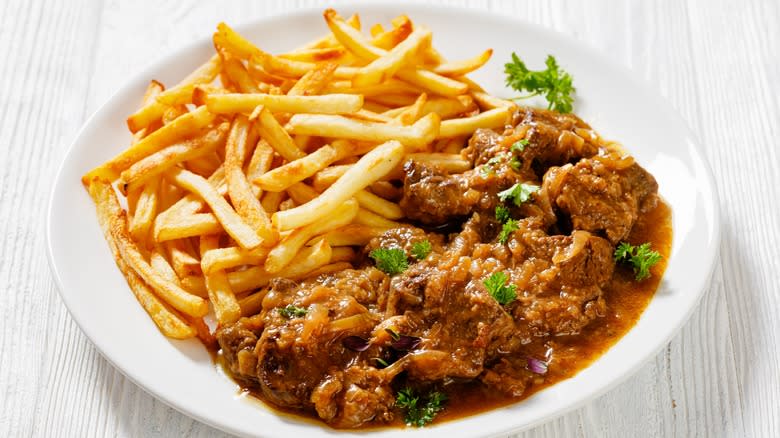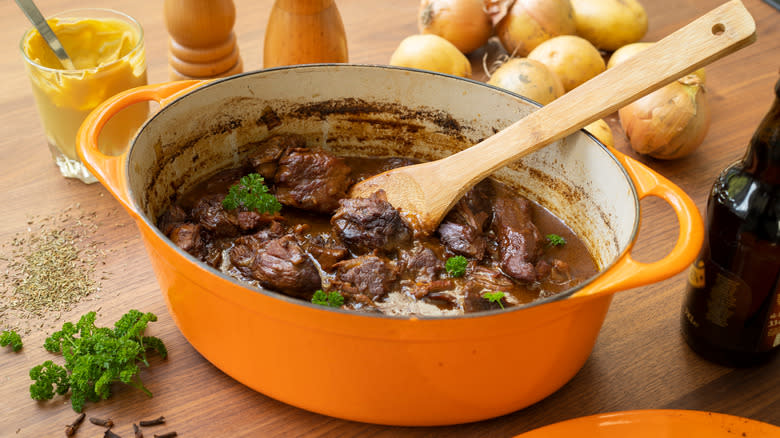Carbonnade Is The Rich Belgian Beef Stew Made With Dark Beer

Few dishes hit the comforting note of a beef stew. With a savory, complex flavor, underlaid with tender pieces of beef, it's the ideal food to huddle up with during a cold winter night. From Ireland to Puerto Rico, renditions of the dish exist around the globe. And there happens to be a version in Belgium, too.
Called carbonnade, this slightly liquid beef dish is full of delightful flavors. Herbal, slightly sweet, and aromatic, it owes its complexity to one of Belgium's most infamous products: beer. Up to a bottle of a dark brown-style brew goes into the dish, imbuing a character that makes it uniquely Belgian.
With a slow simmer, the food melds into a flavorful and satiating result. And best of all, it only gets better the longer it sits -- with subsequent reheating, the taste intensifies -- which is all the more reason it's traditionally crafted in a big batch to share.
Read more: 20 Popular Canned Soups, Ranked Worst To Best
Background Of Carbonnade

Carbonnade, also called Vlaamse stoverij is a Flemish food that's now one of Belgian's national dishes. The utilized cooking techniques combine German, French, and Dutch influences into a result that's distinctly Belgian. Its expanded name Carbonnade à la Flamande translates to Flemish stew, but its root etymology stems from the word for coal, a remnant of mining history. Before the dish was stewed, workers reheated affordable cuts of beef over coals. Later, the technique shifted to reheating the beef in liquid -- oftentimes beer -- creating a dish that's like a Belgian spin on boeuf bourguignon.
Around since the 18th century, carbonnade has been prepared by families for get-togethers and holidays for decades. It encompasses many regional variations, with version substituting beef chunks for offal, and occasionally horse meat. Additionally, varying beers are utilized in its preparation, too. Though all of its varying renditions, carbonnade's dependable factor is a hearty pot made for sharing.
How Carbonnade Is Made

Carbonnade's preparation is based on slow, patient simmering. The dish reaches for boneless stewing beef with a medium amount of fat, slow-cooking the meat until tender. Base aromatics are kept simple -- only onions -- which are caramelized to a soft consistency. Some add bacon for extra fat and flavor, using the oily base first to sear the chunks of beef.
The stew liquid itself is comprised principally of beer, favoring dark ales. Common examples include Abbey-brewed ales like Chimay, or strong ales favored in Nord-Pas-de-Calais -- all flavorful, strong, and aromatic options. Some also add beef stock for extra meat taste or simply water for more liquid. Added flavorings include herbs and spices like bay leaves, cloves, and thyme, sometimes tied in a bouquet garni with a French influence. Plus, mustard and brown sugar add savory pungency and a sweet note to carbonnade. For thickening, flour and bread tie everything together.
Carbonnade is cooked to a relatively liquid consistency and spooned on a plate with a parsley garnish. It's traditionally served with potatoes, most frequently in the form of french fries, but occasionally mashed, boiled, or potato croquettes instead. A hefty serving of the starchy carb is a warranted addition -- it pays off to sop up as much of the delicious sauce as possible.
Read the original article on Tasting Table.


